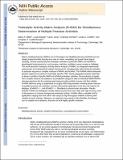Proteolytic Activity Matrix Analysis (PrAMA) for simultaneous multiple protease activities
Author(s)
Miller, Aaron; Barkal, Layla J.; Jeng, Karen; Herrlich, Andreas; Moss, Marcia L.; Griffith, Linda G.; Lauffenburger, Douglas A.; ... Show more Show less
DownloadLauffenburger-2011-Proteolytic Activity Matrix Analysis.pdf (2.114Mb)
OPEN_ACCESS_POLICY
Open Access Policy
Creative Commons Attribution-Noncommercial-Share Alike
Terms of use
Metadata
Show full item recordAbstract
Matrix metalloproteinases (MMPs) and A Disintegrin and Metalloproteinases (ADAMs) are two related protease families that play key roles in matrix remodeling and growth factor ligand shedding. Directly ascertaining the proteolytic activities of particular MMPs and ADAMs in physiological environments in a non-invasive, real-time, multiplex manner remains a challenge. This work describes Proteolytic Activity Matrix Analysis (PrAMA), an integrated experimental measurement and mathematical analysis framework for simultaneously determining the activities of particular enzymes in complex mixtures of MMPs and ADAMs. The PrAMA method interprets dynamic signals from panels of moderately specific FRET-based polypeptide protease substrates to deduce a profile of specific MMP and ADAM proteolytic activities. Deconvolution of signals from complex mixtures of proteases is accomplished using prior data on individual MMP/ADAM cleavage signatures for the substrate panel measured with purified enzymes. We first validate PrAMA inference using a compendium of roughly 4000 measurements involving known mixtures of purified enzymes and substrates, and then demonstrate application to the live-cell response of wildtype, ADAM10−/−, and ADAM17−/− fibroblasts to phorbol ester and ionomycin stimulation. Results indicate PrAMA can distinguish closely related enzymes from each other with high accuracy, even in the presence of unknown background proteolytic activity. PrAMA offers a valuable tool for applications ranging from live-cell in vitro assays to high-throughput inhibitor screening with complex enzyme mixtures. Moreover, our approach may extend to other families of proteases, such as caspases and cathepsins, that also can lack highly-specific substrates.
Date issued
2010-12Department
Massachusetts Institute of Technology. Department of Biological Engineering; Whitehead Institute for Biomedical ResearchJournal
Integrative Biology
Publisher
Royal Society of Chemistry
Citation
Miller, Miles A. et al. “Proteolytic Activity Matrix Analysis (PrAMA) for simultaneous determination of multiple protease activities.” Integrative Biology 3 (2011): 422. Web. 16 Nov. 2011. © 2011 Royal Society of Chemistry
Version: Author's final manuscript
ISSN
1757-9708
1757-9694